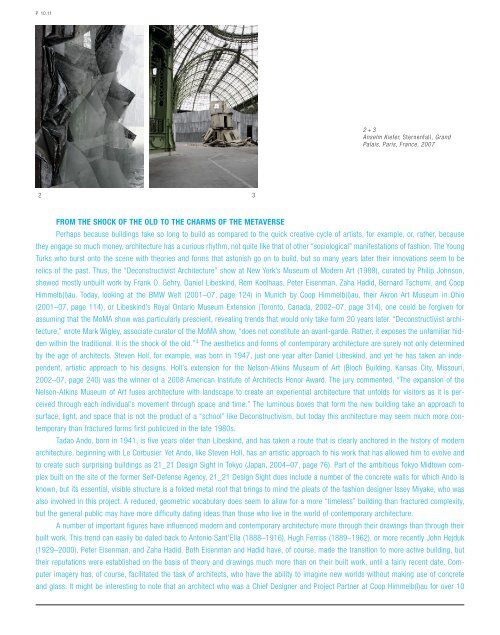PROJECT MANAGEMENT Florian Kobler, Cologne - IDATBCN
PROJECT MANAGEMENT Florian Kobler, Cologne - IDATBCN
PROJECT MANAGEMENT Florian Kobler, Cologne - IDATBCN
Create successful ePaper yourself
Turn your PDF publications into a flip-book with our unique Google optimized e-Paper software.
P 10.11<br />
2 3<br />
FROM THE SHOCK OF THE OLD TO THE CHARMS OF THE METAVERSE<br />
Perhaps because buildings take so long to build as compared to the quick creative cycle of artists, for example, or, rather, because<br />
they engage so much money, architecture has a curious rhythm, not quite like that of other “sociological” manifestations of fashion. The Young<br />
Turks who burst onto the scene with theories and forms that astonish go on to build, but so many years later their innovations seem to be<br />
relics of the past. Thus, the “Deconstructivist Architecture” show at New York’s Museum of Modern Art (1988), curated by Philip Johnson,<br />
showed mostly unbuilt work by Frank O. Gehry, Daniel Libeskind, Rem Koolhaas, Peter Eisenman, Zaha Hadid, Bernard Tschumi, and Coop<br />
Himmelb(l)au. Today, looking at the BMW Welt (2001–07, page 124) in Munich by Coop Himmelb(l)au, their Akron Art Museum in Ohio<br />
(2001–07, page 114), or Libeskind’s Royal Ontario Museum Extension (Toronto, Canada, 2002–07, page 314), one could be forgiven for<br />
assuming that the MoMA show was particularly prescient, revealing trends that would only take form 20 years later. “Deconstructivist archi-<br />
tecture,” wrote Mark Wigley, associate curator of the MoMA show, “does not constitute an avant-garde. Rather, it exposes the unfamiliar hid-<br />
den within the traditional. It is the shock of the old.” 4 The aesthetics and forms of contemporary architecture are surely not only determined<br />
by the age of architects. Steven Holl, for example, was born in 1947, just one year after Daniel Libeskind, and yet he has taken an inde-<br />
pendent, artistic approach to his designs. Holl’s extension for the Nelson-Atkins Museum of Art (Bloch Building, Kansas City, Missouri,<br />
2002–07, page 240) was the winner of a 2008 American Institute of Architects Honor Award. The jury commented, “The expansion of the<br />
Nelson-Atkins Museum of Art fuses architecture with landscape to create an experiential architecture that unfolds for visitors as it is per-<br />
ceived through each individual’s movement through space and time.” The luminous boxes that form the new building take an approach to<br />
surface, light, and space that is not the product of a “school” like Deconstructivism, but today this architecture may seem much more con-<br />
temporary than fractured forms first publicized in the late 1980s.<br />
2+3<br />
Anselm Kiefer, Sternenfall, Grand<br />
Palais, Paris, France, 2007<br />
Tadao Ando, born in 1941, is five years older than Libeskind, and has taken a route that is clearly anchored in the history of modern<br />
architecture, beginning with Le Corbusier. Yet Ando, like Steven Holl, has an artistic approach to his work that has allowed him to evolve and<br />
to create such surprising buildings as 21_21 Design Sight in Tokyo (Japan, 2004–07, page 76). Part of the ambitious Tokyo Midtown com-<br />
plex built on the site of the former Self-Defense Agency, 21_21 Design Sight does include a number of the concrete walls for which Ando is<br />
known, but its essential, visible structure is a folded metal roof that brings to mind the pleats of the fashion designer Issey Miyake, who was<br />
also involved in this project. A reduced, geometric vocabulary does seem to allow for a more “timeless” building than fractured complexity,<br />
but the general public may have more difficulty dating ideas than those who live in the world of contemporary architecture.<br />
A number of important figures have influenced modern and contemporary architecture more through their drawings than through their<br />
built work. This trend can easily be dated back to Antonio Sant’Elia (1888–1916), Hugh Ferriss (1889–1962), or more recently John Hejduk<br />
(1929–2000), Peter Eisenman, and Zaha Hadid. Both Eisenman and Hadid have, of course, made the transition to more active building, but<br />
their reputations were established on the basis of theory and drawings much more than on their built work, until a fairly recent date. Com-<br />
puter imagery has, of course, facilitated the task of architects, who have the ability to imagine new worlds without making use of concrete<br />
and glass. It might be interesting to note that an architect who was a Chief Designer and Project Partner at Coop Himmelb(l)au for over 10


